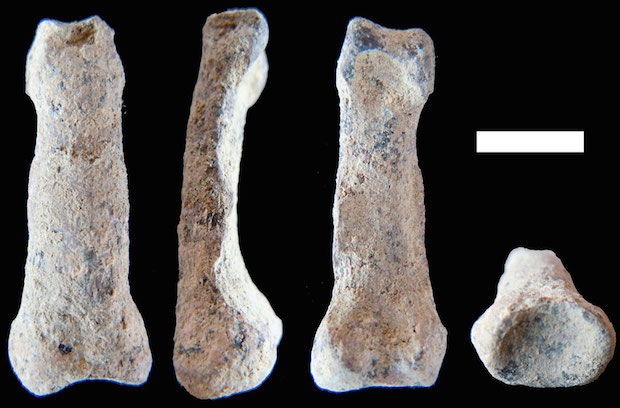Earliest human hand bone unearthed in Africa
Scientists have unearthed the oldest modern-looking hand bone from a human ancestor at a site in Africa, demonstrating that features we take for granted, like the ability to grip, go much further back than previously believed.
The discovery of a little finger of a left hand of an unknown human ancestor was found in the famous Olduvai Gorge in Tanzania. It dates back least 1.84 million years, more than 600,000 years older than next-oldest example, a human-like hand bone found at a site in Spain known as Sierra de Atapuerca.
In a study about the discovery published Tuesday in Nature Communications, Manuel Dominguez-Rodrigo and colleagues said this is the first evidence of an early hominin species that made the transition from having hands of tree-dwellers - known for their curved, more primitive finger bones - to ones with features that would be almost identical to modern humans.
"This discovery that we made is the oldest evidence of a completely terrestrial creature," Dominguez-Rodrigo, who is also one of the principal investigators on the site known as The Olduvai Paleonthropology and Paleoecology Project, told CBS News.
"That creature was no longer using the trees," he said. "By liberating the hand from the tree climbing locomotion and adaption, it became very useful for manipulation. It became the modern hand that we have. Basically what this discovery is saying is that our modern hand, which is the best manipulation hand in any primates, at least has a 2-million-year history."
The discovery of the hand bone also should add to our understanding of human evolution, since the development of the hand is closely linked to development of human intelligence. It should also shed light on stone tools used by our early ancestors in such activities as hunting and slicing up carcasses - the timing of which has sparked heated debates within the anthropology community.
Anthropologist Louis Leakey first found stone tools in Olduvai Gorge more than 80 years ago; the oldest of these so-called Oldowan tools were later dated to 2.6 million years old and examples have since also been found at a site in Ethiopia. Leakey, working with his wife Mary, later found bones there from a species they named Homo habilis or the "handy man." That convinced most anthropologists that our lineage alone took the cognitive leap to create tools - a theory that was linked to climate change and the spread of the savannah grasslands.
Scientists in May announced they had found stone tools that date back as far as 3.3 million years, which would make them the oldest ever. But Dominguez-Rodrigo and others are not convinced of the date.
"When we look at the bone, these fingers of this hand were as skillful as our fingers in our hand. This creature could make all the different types of grips that humans have. It could hold things as modern humans can," he said. "This creature could use his hand the same we do. He could master stone-tool making the same way we do it."
And because stone tools have dated back as far back as 2.6 million years, Dominguez-Rodrigo said he "wouldn't be surprised if we found a modern hand that is substantially older, at least a half-million years older."
But who was this creature?
From the hand bone alone, Dominguez-Rodrigo and his colleagues were able to also say he was probably about 6 feet tall and much more modern looking than other hominins who lived around the same time, including Paranthropus boisei and Homo habilis.
But without more fossil remains, researchers can't say for sure where this early ancestor fits into our family tree. Dominguez-Rodrigo said it could turn out to be Homo erectus, "but much older than we thought he was," or a "creature very similar to Homo erectus that we haven't found yet."
So Dominguez-Rodrigo and his team will keep digging at the site, which before the hand bone also turned up in 2009 a piece of child's skull that dates back 1.5 million years and demonstrated the earliest evidence a disease related to the lack of vitamin B12, which occurs when you don't eat meat. They also found a partial skeleton of Paranthropus boisei in 2010, which is of similar age to the finger bone.
"We need teeth. With teeth, we can actually know if we are talking about Homo erectus or if we are talking about something else," Dominguez-Rodrigo said. "If we don't get teeth, we should get some other parts of the skeleton that we have well identified in other hominids, particularly Homo erectus."
Dominguez was confident the missing pieces would be eventually found on the site.
"We are finding more things now, ever since we discovered this hand bone. We are starting to pull out bones from the foot and the foot is telling us the same story," he said. "It's a big foot. It probably belongs to the same individual. I'm very optimistic that we are going to find more pieces of this individual as this excavation goes on."


